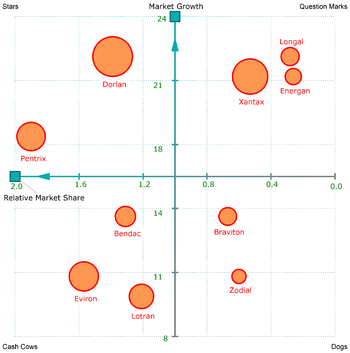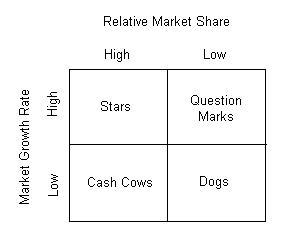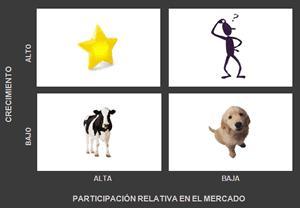
English: Folio plot of a BCG Matrix Analysis using an example data set. The folio plot visualizes the relative market share of a portfolio (hence the name) of products versus the growth of their market. The measurements are visualized as squares. The objects are visualized with circles that differ in size by their sales volume. The PNG was created with Foliomap. (Photo credit: Wikipedia)

Boston Consulting Group (Photo credit: Wikipedia)

English: Boston Consulting Group Matrix Español: Matriz de Boston Consulting Group (Photo credit: Wikipedia)
Chapter 6 – Strategy Analysis and Choice
Overview
Chapter 6 explains how to formulate effective strategies once the internal and external audits are completed. Chapter 6 presents and exemplifies six widely used strategic planning matrices: SWOT (Strengths-Weaknesses-Opportunities-Threats) Matrix, BCG (Boston Consulting Group on page 179) Matrix, SPACE (Strategic Position and Action Evaluation on page 172) Matrix, IE (Internal-External on page 183) Matrix, Grand Strategy Matrix on page 184, and the QSPM (Quantitative Strategic Planning Matrix for Starbucks on page 189).
All analytical techniques have limitations, but analytical techniques are essential for assimilating and organizing information in a way that enhances strategic decision-making. Due to various limitations, the book advocates that five matching tools be utilized in conjunction with each other: BCG, IE, SWOT, SPACE, and GRAND.
The SWOT Matrix is the most widely used strategic planning matrix in the world, so carefully go over Figure 6-3 “A SWOT Matrix for a Retail Computer Store.” on page 171.
Look at the matching notation after each strategy in red: ie (S4, O3) The two basic alternative strategies faced by this store: 1) remodel existing store or 2) build a new store in new location. The QSPM presented later in this chapter will answer which of these two alternatives is best.
Chapter 6 also describes the nature and role of boards of directors in strategic planning on page 192.
A board of directors is a body of elected or appointed members who jointly oversee the activities of a company or organization. Other names include board of governors, board of managers, board of regents, board of trustees, and board of visitors. It is often simply referred to as “the board”.
“A board’s activities are determined by the powers, duties, and responsibilities delegated to it or conferred on it by an authority outside itself. These matters are typically detailed in the organization’s bylaws. The bylaws commonly also specify the number of members of the board, how they are to be chosen, and when they are to meet.” Look at your company’s website and find out who sits on their Board. Then investigate the Board Committees.
Typical duties of boards of directors may include:
- establishing broad policies and objectives;
- selecting, appointing, supporting and reviewing the performance of the chief executive;
- ensuring the availability of adequate financial resources;
- approving annual budgets;
- being accountable to the stakeholders
The Chapter 6 Learning Objectives presented in the textbook are reiterated below:
1. Describe a three-stage framework for choosing among alternative strategies.
2. Explain how to develop a Strengths-Weaknesses-Opportunities-Threats (SWOT) Matrix, Strategic Position and Action Evaluation (SPACE) Matrix, Boston Consulting Group (BCG) Matrix, Internal-External (IE) Matrix, and Quantitative Strategic Planning Matrix (QSPM).
3. Identify important behavioral, political, ethical, and social responsibility considerations in strategy analysis and choice.
4. Discuss the role of intuition in strategic analysis and choice.
5. Discuss the role of organizational culture in strategic analysis and choice.
6. Discuss the role of a board of directors in choosing among alternative strategies.
Complete Exercise 6D: Develop a BCG Matrix for PepsiCo and Tweet your graph.
Teaching Tips

